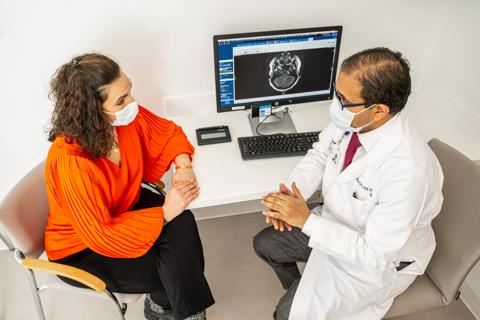Advertisement
Some mutations associated with higher risk of relapse

Although studies have established the prognostic significance of specific genetic mutations in acute myeloid leukemia (AML) and myelodysplastic syndromes (MDS), the role of mutations as prognostic factors of outcomes after hematopoietic cell transplantation (HCT) is still unclear.
Advertisement
Cleveland Clinic is a non-profit academic medical center. Advertising on our site helps support our mission. We do not endorse non-Cleveland Clinic products or services. Policy
A study from Cleveland Clinic investigators aimed to determine the impact of mutations on post-HCT outcomes in patients with AML and MDS as well as the clinical significance of variant allelic frequency (VAF) of the most common gene mutations on patient outcomes.
“Although exploratory, this study is among the first investigations of the clonal burden of common mutations in AML and MDS and their association with post-transplant outcomes,” says Betty K. Hamilton, MD, hematologic oncologist and lead author of the study.
Study findings were published in Bone Marrow Transplantation and shed new light on the prognostic value of common mutations and VAFs in patients with AML and MDS.
The study was conducted on two separately analyzed patient cohorts: patients with MDS (N=80) and patients with AML (N=116). Genomic DNA was extracted from bone marrow mononuclear cells obtained before HCT at a time of significant disease activity. The samples were sequenced in order to identify the 64 most common mutations found in MDS and AML. Mutations were analyzed both individually and based on functional categories; VAF was determined for those mutations identified in at least six patients. The frequencies of most common mutations were calculated and associations between four transplant outcomes — nonrelapse mortality (NRM), overall survival (OS), relapse and relapse-free survival (RFS) — and individual mutations and their VAFs were determined.
The most common mutations in patients with AML were TET2 (14.7 percent), FLT3-ITD (12.9 percent), DNMT3A (12.1 percent) and RUNX1 (7.8 percent). In patients with MDS, the most common mutations were ASXL1 (12.5 percent), SRSF2 (12 percent), TET2 (8.8 percent) and TP53 (8.8 percent). Mutation clustering was not observed in either MDS or AML.
Advertisement
The presence of SRSF2 and TET2 mutations was associated with higher risk of NRM in patients with AML, while the presence of mutations in the RNA-splicing pathway was prognostic for OS. Disease status and complex cytogenetics were significantly associated with worse RFS. Except for mutations in the RNA splicing pathway, individual mutations or VAFs had no prognostic value for OS in this group of patients.
“The lack of associations in the AML cohort may be partially explained by heterogeneity of mutations and small sample size,” explains Dr. Hamilton. “Our main findings were in the cohort of patients with MDS.”
Interestingly, in the MDS cohort, the findings were distinct, and several associations between VAF and outcome parameters were identified.
“In general, we found that higher allelic frequencies of certain mutations in this group of patients were associated with worse outcomes,” says Dr. Hamilton. “More specifically, we found that complex cytogenetics and mutations in the U2AF1 gene were associated with worse RFS. Furthermore, we found that high VAF (> 33 percent) of TP53 and EZH2 mutations were also associated with worse OS and RFS.”
In addition, mutations in SF3B1 and the RNA splicing pathway were associated with higher risk of relapse in patients with MDS.
The authors note that prior research has pointed to the adverse effects of TP53 mutation in myeloid malignancies, especially when combined with a complex karyotype. The findings from the current study suggest that the degree of clonal burden may be associated with a poorer outcome; however, the authors caution that these findings are exploratory and need to be verified in a larger cohort.
Advertisement
Dr. Hamilton believes that their study begs additional important questions about the effects of mutations on transplant outcomes in patients with myeloid malignancies.
“We still need to clarify what is important to look at when we study mutations and disease outcomes,” she says. “Refining the prognostic value of mutations and understanding how to best utilize this information remains a challenge.”
Study co-author, Aziz Nazha, MD, Department of Hematology and Medical Oncology, is taking things one step further by using machine learning algorithms to investigate the significance of some of these mutations.
“This is an exciting new approach to evaluate large amounts of complex data, and we will have to see how this can be used clinically,” says Dr. Hamilton.
Image: Confocal image showing the accumulation of myeloid hematopoietic cells throughout the mesenteric adipose tissue. Credit: National Institute of Allergy and Infectious Diseases, National Institutes of Health. Licensed. No changes were made.
Advertisement
Advertisement

Study measures real-world outcomes for relapsed or refractory large B-cell lymphoma

Optimized responses in transplant- and CAR T-cell therapy-eligible patients

Findings from large database important to inform clinical practice

Socioeconomic disparities have a notable influence on access to allogeneic hematopoietic cell transplant

What’s coming up at ASH and beyond

Blinatumomab plus chemotherapy improves overall survival and relapse-free survival over chemotherapy alone

First-ever U.S. population-level retrospective analysis reveals many patients with systemic mastocytosis need faster intervention

Global R&D efforts expanding first-line and relapse therapy options for patients